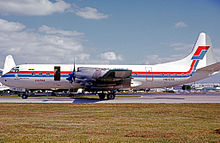|
SAM Colombia
SAM (Spanish acronym: Sociedad Aeronáutica de Medellín) was a Colombian airline. With its main hub at El Dorado International Airport in Bogotá, SAM operated domestic and international routes and was a subsidiary of Avianca. In 2004, its headquarters were in the Avianca headquarters in Bogotá.[1] History
Early operations In the 1940s, a group of entrepreneurs promoted the idea of providing the city of Medellín with an air transportation system that would connect with the rest of the country and the world. In October 1945, at the 3rd Notary Public's Office, a deed incorporating Sociedad Aeronáutica de Medellín S.A. was recorded. The airline was in the minds of its first partners and promoters, who from the beginning of 1946 began to bring their dream to fruition. The company had originally intended to acquire small aircraft, but the concept changed and grew. The airline would acquire long-range aircraft to secure the cargo market to and from Miami. The airline's first Douglas C-47 arrived in October 1946 and departed from Las Playas Airport in Medellín heading to Miami in the midst of much celebration. SAM transported mail from Medellín to Bogotá, Barrancabermeja, Bucaramanga, Cartagena, and later began regular flights to Panama and Miami with the Curtiss C-46. However, Avianca, which was the owner of several airports in the country, suspended SAM's operations due to a ten-month delay in the payment of a debt. In 1954, after the merger of Avianca and LANSA, SAM restarted operations and created a subsidiary called RAS - Rutas Aéreas SAM. The company was advised by the Dutch airline KLM in its division in the Antilles. Later years In the second year of activities, SAM's wings grew and began to embrace the world of the nearest Colombian cities with flights to Bogotá, Bucaramanga, Planeta Rica and Barranquilla. The airline grew quickly. Industrial and commercial activity increased to the point that in 1950s the fleet comprised 18 cargo aircraft and the destinations were now far afield. SAM's aircraft flew to and from the Caribbean and South America. Having proved its efficiency in air transportation and establishing the routes that put an end to the isolation of Medellín and Colombia, in 1958 SAM decided to begin carrying passengers. Passenger air service began with a DC-3 and a C-46, and one of the early milestones was San Andres, where it was the first airline to provide service to the island.[citation needed] Two years later, the first DC-4 was added to the fleet with a capacity of 65 passengers, but it was in 1970 that SAM became notable for inaugurating the Jet-Prop era in Colombia. The Santo Domingo Group had provided broader capital to enable accelerated modernization and expanded market share. With the introduction of the Lockheed L-188 into service, the expansion into Central America was made possible and passenger services began to Nicaragua, El Salvador, Guatemala and Costa Rica with regular freight schedules that were operated to Miami. Later in 1977, SAM introduced the Boeing 720B which were transferred from Avianca, with which the Lockheed Electras were returned to Eastern Air Lines. Around 1990, SAM requested to resume cargo flights to the United States and the company made a request to Challenger Air Cargo to lease one of its Boeing 757s, at the same time that Avianca suspended cargo services to Miami, and sold its 747 freighters. The request was cancelled and SAM leased a Boeing 707-320C to carry out the flights to Miami. Starting in 1992, the company modernized its fleet with the Boeing 727-200, subsequently the Avro RJ100, and the De Havilland Canada Twin Otter as well. With these modern aircraft, SAM connected the most important cities of the country, as well as several regional and international destinations. However, there were problems with the RJ100 engines, which were paralyzed on the ground and the company had to use aircraft from Avianca to cover its flights, and the aircraft were returned to the manufacturer British Aerospace in March 2000, and purchased 3 Cessna 208 Caravans. Avianca's Fokker 50 and McDonnell Douglas MD-83 were also assigned. On May 20, 2002, SAM along with Avianca and ACES, joined and formed the Alianza Summa to offer a more efficient service to compete in a new struggling marketplace. However, in the following year, ACES was dissolved and Avianca was purchased by the Synergy Group and change its image, for which the colors of SAM disappeared. However, SAM operated 15 exclusive Fokker 100s in the Avianca livery with a sign that read "Operated by Sam" on the fuselage. SAM closed its operations on October 4, 2010, when its final flight took off from Bogotá bound for Medellín. With this flight, SAM was permanently merged into Avianca.[2][3] FleetFinal fleet As of May 2010, the SAM fleet consisted of the following aircraft:[4]
Former fleetSAM had in the past operated a variety of aircraft, including:[5]
Accidents and incidents
In other areasSAM was the main sponsor of the Atlético Nacional football team between 1988 and 1994, the airline's logo was used on the front of their jersey during competitions of those years, including the 1989 Copa Libertadores. See alsoReferences
External linksWikimedia Commons has media related to SAM Colombia. |
|||||||||||||||||||||||||||||||||||||||||||||||||||||||||||||||||||||||||||||||||||||||||||||||||||||||||||||||||||||||||||||||||||||||||||||||||||||||||||||||||||
